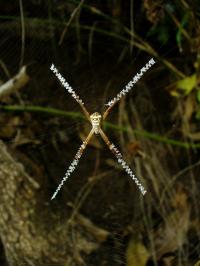
Decorative white silk crosses are an ingenious tactic used by orb-weaving spiders to protect their webs from damage. Decorative white silk crosses are an ingenious tactic used by orb-weaving spiders to protect their webs from damage, a new study from the University of Melbourne has revealed.
The team, led by Dr Andre Walter and Professor Mark Elgar from the University of Melbourne's Department of Zoology, found that orb-weaving spiders respond to severe damage to their webs by building bigger silk crosses, but if the damage is mild they don't bother adding extra decoration.
Professor Mark Elgar said web damage is costly for spiders as a lot of nutritional resources are required to rebuild a web. "So they evolved this ingenious way to minimise unwanted damage," he said. __IMAGE_2
"It's much like we mark glass windows with tape to prevent people walking into them," he said.
The team collected a group of orb-weaving spiders and left them to build their webs in the laboratory. Some of the completed webs were severely damaged, others lightly damaged and the remainder left alone. The response of the spiders was then observed.
"The fact that spiders increased their decorating activity in response to severe damage but didn't increase their decorating following light damage suggests that the conspicuous building of silk crosses serves to make webs more visible to animals that might accidentally walk or fly into them," Professor Elgar said.
Adding silk decorations to spiders' orb-webs was first reported over a century ago but why these spiders decorate their webs has been the topic of controversial debate for decades.
"Our study helps unravel this mystery," Professor Elgar said.
Source : University of Melbourne
 Print Article
Print Article Mail to a Friend
Mail to a Friend
